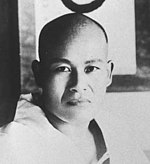Portal:Martial arts/Selected biography/15
Morihei Ueshiba (植芝 盛平, Ueshiba Morihei, December 14, 1883 – April 26, 1969) was a Japanese martial artist and founder of the martial art of aikido. He is often referred to as "the founder" Kaiso (開祖) or Ōsensei (大先生/翁先生), "Great Teacher".
The son of a landowner from Tanabe, Ueshiba studied a number of martial arts in his youth, and served in the Japanese Army during the Russo-Japanese War. After being discharged in 1907, he moved to Hokkaidō as the head of a pioneer settlement; here he met and studied with Takeda Sōkaku, the headmaster of Daitō-ryū Aiki-jūjutsu. On leaving Hokkaido in 1919, Ueshiba joined the Ōmoto-kyō movement, a Shinto sect, in Ayabe, where he served as a martial arts instructor and opened his first dojo. He accompanied the head of the Ōmoto-kyō group, Onisaburo Deguchi, on an expedition to Mongolia in 1924, where they were captured by Chinese troops and returned to Japan. The following year, he had a profound spiritual experience, stating that, "a golden spirit sprang up from the ground, veiled my body, and changed my body into a golden one." After this experience, his martial arts technique became gentler, with a greater emphasis on the control of ki.
Ueshiba moved to Tokyo in 1926, where he set up what would become the Aikikai Hombu Dojo. By this point he was comparatively famous in martial arts circles, and taught at this dojo and others around Japan, including in several military academies. In the aftermath of World War II the Hombu dojo was temporarily closed, but Ueshiba had by this point left Tokyo and retired to Iwama, and he continued training at the dojo he had set up there. From the end of the war until the 1960s, he worked to promote aikido throughout Japan and abroad. He died from liver cancer in 1969.
After Ueshiba's death, aikido continued to be promulgated by his students (many of whom became noted martial artists in their own right). It is now practiced around the world. (Full article...)

